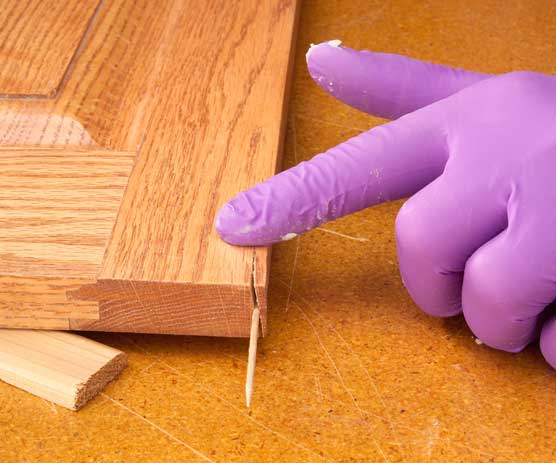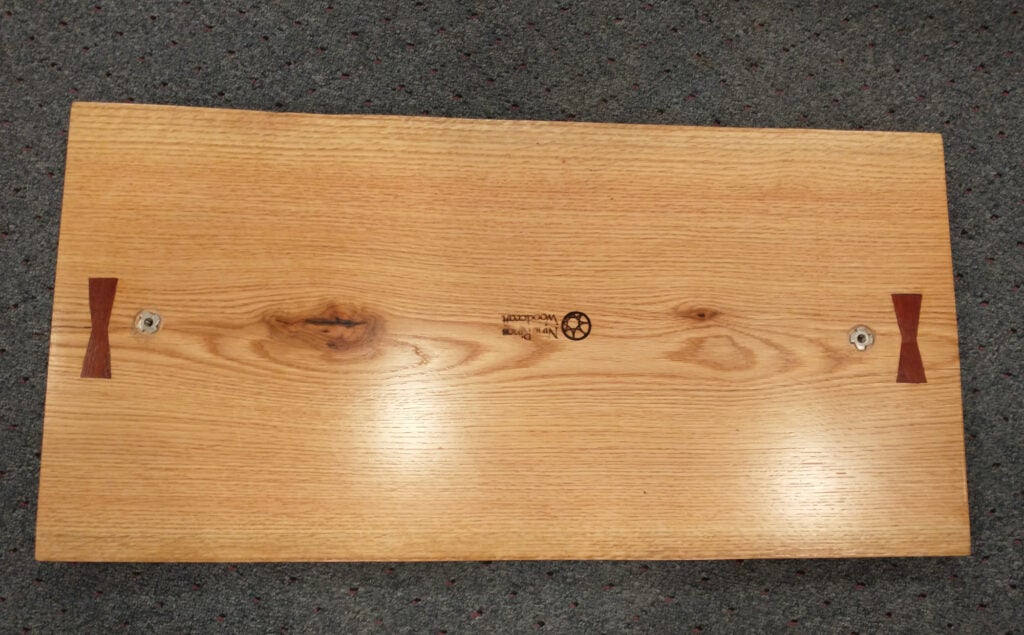Wood is a timeless and elegant material that adds warmth and character to any space. However, over time, even the sturdiest of wooden surfaces can develop cracks, leaving us puzzled and frustrated. But fear not, for in this guide, we will delve into the art of fixing cracked wood and restore the beauty and integrity of your cherished wooden pieces.
Cracks in wood can occur due to a multitude of reasons – from natural expansion and contraction to accidental impacts or age-related wear and tear. Whatever the cause may be, it is essential to address these cracks promptly to prevent further damage and ensure the longevity of your wooden items. In this comprehensive guide, we will explore various techniques and expert tips to mend cracked wood, whether it be a beloved antique table, a cherished wooden flooring, or a sentimental heirloom. So, roll up your sleeves, grab your tools, and let’s embark on a journey to revive your cracked wood to its former glory!
How to fix cracked wood:
- Assess the crack and determine its size.
- If it’s a small crack, use wood filler to fill it in.
- For larger cracks, use a wood glue to bind the separated pieces together.
- Apply clamps or weights to hold the wood in place while the glue dries.
- Once dry, sand down the repaired area and apply a matching wood stain or paint.

How to Fix Cracked Wood: A Step-by-Step Guide
Wooden furniture and fixtures can be prone to cracking, whether due to age, changes in humidity, or other factors. However, with the right tools and techniques, you can repair cracked wood and restore its beauty and functionality. In this guide, we will walk you through the process of fixing cracked wood, step by step.
Step 1: Assess the Damage
The first step in fixing cracked wood is to assess the extent of the damage. Carefully examine the crack to determine its length, width, and depth. This will help you determine the best course of action for repair. For small cracks, simple DIY methods may suffice, while larger and more severe cracks may require professional intervention.
Once you have assessed the damage, make sure to clean the cracked area thoroughly. Remove any loose debris, dirt, or old adhesive. This will ensure a clean surface for the repair process.
Step 2: Fill the Crack
After cleaning the cracked area, it’s time to fill the crack. There are several options for fillers, depending on the size and nature of the crack. For small cracks, wood putty or epoxy-based fillers can be used. Apply the filler carefully, following the manufacturer’s instructions. Use a putty knife or a similar tool to spread the filler evenly over the crack.
If the crack is larger or more severe, consider using wooden dowels or splines to reinforce the repair. Drill holes along the crack and insert the dowels or splines, ensuring a tight fit. Apply wood glue to the dowels/splines before inserting them into the holes. Once inserted, cut off any excess material and sand it down to create a smooth surface.
Step 3: Sand and Finish
Once the filler has dried or the dowels/splines have been installed, it’s time to sand the repaired area. Start with coarse-grit sandpaper to remove any excess filler and level the surface. Gradually switch to finer-grit sandpaper to achieve a smooth finish.
After sanding, wipe away any dust or debris and apply a wood finish or stain to match the surrounding wood. Follow the manufacturer’s instructions for application and drying times. Once the finish has dried, buff the repaired area gently to blend it with the rest of the wood.
Step 4: Prevent Future Cracks
To prevent future cracks in your wood furniture or fixtures, it’s essential to take preventive measures. Avoid exposing wood to extreme temperature and humidity changes, as these can cause the wood to expand and contract, leading to cracks. Use a humidifier or dehumidifier to maintain a stable moisture level in your home.
Regularly inspect and maintain your wood items, ensuring they are kept clean and well-conditioned. Apply furniture wax or oil periodically to keep the wood moisturized and protected. Additionally, avoid placing heavy objects on delicate wooden surfaces to prevent stress and potential cracking.
Step 5: Seek Professional Help if Needed
If the crack in your wood is severe or you are unsure about your DIY repair skills, it’s always best to seek professional help. A professional woodworker or furniture restorer will have the expertise and tools necessary to fix the crack effectively and ensure a long-lasting repair.
Remember, attempting complex repairs without the right knowledge and experience can cause further damage to your wood. It’s better to invest in professional assistance to save you time, money, and potential frustration.
Frequently Asked Questions
Here are some commonly asked questions about fixing cracked wood:
Question 1: How do I fix a crack in wood?
First, you’ll need to assess the severity of the crack. If it is a small crack, you can use wood glue to fix it. Apply the glue to the crack and then use clamps or weights to hold the wood together until the glue dries. For larger cracks, you may need to use wood filler. Apply the filler to the crack, making sure to fill it completely. Once the filler has dried, sand it down until it is smooth and then finish with a coat of paint or varnish.
It is important to note that fixing a crack in wood is a temporary solution. Over time, the crack may reappear or new cracks may form. To prevent this, it is crucial to address any underlying issues, such as excessive moisture or structural problems, that may be causing the cracking.
Question 2: Can I use epoxy to fix a cracked wooden surface?
Yes, epoxy can be an effective solution for fixing cracked wood surfaces. Epoxy is a strong adhesive that can bond wood together and provide structural support. To use epoxy, first clean the cracked area and remove any debris. Mix the epoxy according to the manufacturer’s instructions and apply it to the crack, making sure to fill it completely. Use clamps or weights to hold the wood together until the epoxy cures. Once cured, sand the area to make it smooth and finish with paint or varnish.
Epoxy is particularly useful for repairing larger cracks or for strengthening weak areas in wood. However, it is important to note that epoxy can be difficult to work with, so it is recommended to follow the instructions carefully and take necessary safety precautions.
Question 3: How can I prevent wood from cracking?
To prevent wood from cracking, it is important to properly care for and maintain it. Here are a few tips:
– Avoid exposing wood to extreme temperature changes or excessive moisture, as these can cause the wood to expand and contract, leading to cracks.
– Regularly apply protective finishes, such as paint or varnish, to seal the wood and provide a barrier against moisture.
– Use proper supports and reinforcements, such as brackets or cross braces, to prevent structural stress and warping in wooden furniture or structures.
– Keep wood away from direct sunlight, as prolonged exposure to UV rays can dry out the wood and make it more prone to cracking.
Question 4: When should I seek professional help for fixing cracked wood?
While minor cracks can often be repaired by DIY methods, there are situations where it is best to seek professional help. Consider contacting a professional if:
– The crack is extensive or severe, indicating a potential structural issue.
– You are unsure about the best approach to fix the crack or lack the necessary tools and materials.
– The cracked wood is part of an antique or valuable piece that requires specialized restoration techniques to maintain its integrity and value.
Professional woodworkers or carpenters have the expertise and experience to assess the situation accurately and provide appropriate solutions for fixing cracked wood.
Question 5: Are there any temporary fixes for cracked wood?
Yes, there are temporary fixes that can be used to stabilize cracked wood until a more permanent solution can be implemented. Some temporary fixes include:
– Applying clear tape or adhesive to the crack to hold the wood together temporarily.
– Using clamps or weights to hold the cracked wood in place until a proper repair can be made.
– Inserting a wooden dowel or toothpick into the crack and applying wood glue to secure it.
While these temporary fixes may provide some stability, it is important to remember that they are not long-term solutions. It is recommended to address the underlying issue and seek proper repairs as soon as possible to prevent further damage to the wood.

Woodworking Tip: Finishing – How to Repair Wood Cracks
In conclusion, knowing how to fix cracked wood is an essential skill for any homeowner or woodworker. By understanding the causes of cracking and implementing the appropriate solutions, you can extend the lifespan of your wooden furniture, flooring, or structures. Whether it’s using wood fillers, epoxy resins, or even professional repair services, taking prompt action when cracks appear will help prevent further damage and save you time and money in the long run.
Remember, prevention is key in maintaining the integrity of wooden surfaces. Regularly inspecting and maintaining your wood with appropriate finishes and treatments can minimize the risk of cracks. Additionally, being mindful of humidity levels and temperature changes can help prevent the wood from expanding or contracting excessively, reducing the likelihood of cracks. By following these tips and techniques, you can keep your wood looking beautiful and ensure its durability for years to come. So, next time you encounter a cracked wood surface, don’t panic – equip yourself with the knowledge and tools to fix it with confidence.
- How to Frame a Wooden Jigsaw Puzzle - May 12, 2024
- How to Glue a Wooden Jigsaw Puzzle - May 12, 2024
- How to Decoupage Wood - May 12, 2024